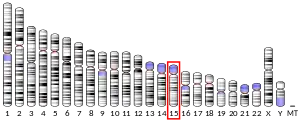ARHGAP11B
ARHGAP11B is a human-specific gene that amplifies basal progenitors, controls neural progenitor proliferation, and contributes to neocortex folding. It is capable of causing neocortex folding in mice. This likely reflects a role for ARHGAP11B in development and evolutionary expansion of the human neocortex, a conclusion consistent with the finding that the gene duplication that created ARHGAP11B occurred on the human lineage after the divergence from the chimpanzee lineage but before the divergence from Neanderthals.[3]
| ARHGAP11B | |||||||||||||||||||||||||
|---|---|---|---|---|---|---|---|---|---|---|---|---|---|---|---|---|---|---|---|---|---|---|---|---|---|
| Identifiers | |||||||||||||||||||||||||
| Aliases | ARHGAP11B, B'-T, FAM7B1, Rho GTPase activating protein 11B, GAP (1-8), ArhGAP11B and human encephalisation | ||||||||||||||||||||||||
| External IDs | OMIM: 616310 GeneCards: ARHGAP11B | ||||||||||||||||||||||||
| |||||||||||||||||||||||||
| |||||||||||||||||||||||||
| Orthologs | |||||||||||||||||||||||||
| Species | Human | Mouse | |||||||||||||||||||||||
| Entrez |
| ||||||||||||||||||||||||
| Ensembl |
| ||||||||||||||||||||||||
| UniProt |
| ||||||||||||||||||||||||
| RefSeq (mRNA) |
| ||||||||||||||||||||||||
| RefSeq (protein) |
| ||||||||||||||||||||||||
| Location (UCSC) | Chr 15: 30.62 – 30.69 Mb | n/a | |||||||||||||||||||||||
| PubMed search | [2] | n/a | |||||||||||||||||||||||
| Wikidata | |||||||||||||||||||||||||
| |||||||||||||||||||||||||
Structure
ARHGAP11B encodes 267 amino acids. A truncated copy of ARHGAP11A, which is found throughout the animal kingdom and encodes a Rho GTPase-activating-protein (RhoGAP domain), ARHGAP11B comprises most of the GAP domain (until lysine-220), followed by a novel C-terminal sequence that lacks the 756 C-terminal amino acids of ARHGAP11A.
Activity
In contrast to full-length ARHGAP11A and ARHGAP11A 1-250, ARHGAP11B, like ARHGAP11A1-220, did not exhibit RhoGAP activity in a RhoA/Rho-kinase–based cell transfection assay. This indicates that the C-terminal 47 amino-acids of ARHGAP11B (after lysine-220) constitute not only a unique sequence, resulting from a frameshifting deletion, but also are functionally distinct from their counterpart in ARHGAP11A. In this assay, co-expression of ARHGAP11B along with ARHGAP11A did not inhibit the latter's RhoGAP activity.[3]
Function
Since several genes involved in intellectual disability encode proteins with RhoGAP domains or other proteins in the Rho signalling pathway, it does not come as a complete surprise that ARHGAP11B is involved in neocortex folding; however, its precise function remains unknown. It has been reported[4] that it is located in mitochondria, where it binds to the adenine nucleotide translocator. It does not affect the adenine nucleotide exchange activity of the translocator, but it does lead to delayed opening of the mitochondrial permeability transition pore, thus allowing for greater sequestration of calcium. Furthermore, the presence of ARHGAP11B in the mitochondria boosts glutaminolysis, most likely due to the ability of mitochondria to sequester calcium, thereby activating mitochondrial matrix dehydrogenases in the citric acid cycle, particularly the oxoglutarate dehydrogenase complex.
References
- ENSG00000286139, ENSG00000284906 GRCh38: Ensembl release 89: ENSG00000274734, ENSG00000286139, ENSG00000284906 - Ensembl, May 2017
- "Human PubMed Reference:". National Center for Biotechnology Information, U.S. National Library of Medicine.
- Florio M, Albert M, Taverna E, Namba T, Brandl H, Lewitus E, et al. (March 2015). "Human-specific gene ARHGAP11B promotes basal progenitor amplification and neocortex expansion". Science. New York, N.Y. 347 (6229): 1465–70. doi:10.1126/science.aaa1975. PMID 25721503.
- Namba T, Dóczi J, Pinson A, Xing L, Kalebic N, Wilsch-Bräuninger M, Long KR, Vaid S, Lauer J, Bogdanova A, Borgonovo B, Shevchenko A, Keller P, Drechsel D, Kurzchalia T, Wimberger P, Chinopoulos C, Huttner WB (March 2020). "Human-Specific ARHGAP11B Acts in Mitochondria to Expand Neocortical Progenitors by Glutaminolysis". Neuron. 105 (5): 867–881.e9. doi:10.1016/j.neuron.2019.11.027. PMID 31883789.
Further reading
- Sudmant PH, Kitzman JO, Antonacci F, Alkan C, Malig M, Tsalenko A, et al. (October 2010). "Diversity of human copy number variation and multicopy genes". Science. 330 (6004): 641–6. doi:10.1126/science.1197005. PMC 3020103. PMID 21030649.


